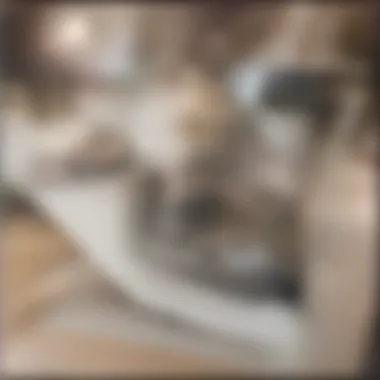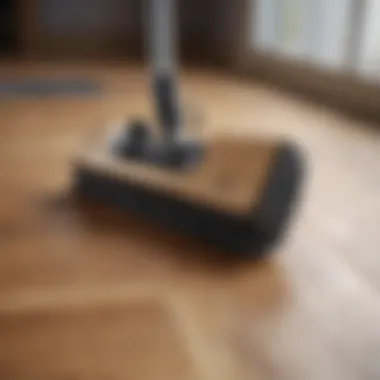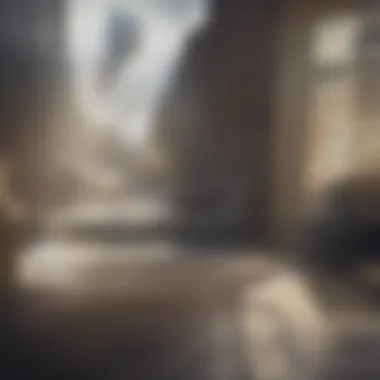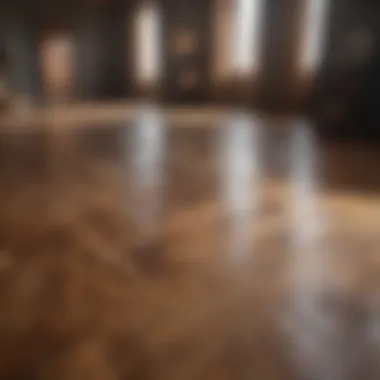A Comprehensive Guide to Cleaning Finished Wood Floors


Intro
Maintaining the beauty and functionality of finished wood floors is vital for any homeowner or cleaning professional. These surfaces can add considerable value and aesthetic appeal to a home. However, they require specific care to preserve their quality over time. This guide outlines effective methods for cleaning and maintaining finished wood floors.
Proper cleaning techniques and tools are essential. Not all cleaning products and methods are suitable for wood floors. Using inappropriate cleaners can damage the finish or wood itself. This article addresses various flooring finishes and recommends specific cleaning solutions tailored to each type. The goal is to provide a comprehensive understanding of how to care for finished wood floors, ensuring they remain in excellent condition for years to come.
Key Points
- Importance of understanding the type of wood finish
- Appropriate tools and cleaning solutions
- Maintenance strategies for longevity
By following these guidelines, homeowners can ensure their wood floors not only look good but also sustain through heavy use. In the sections that follow, we will explore effective tools, techniques, and expert tips for maintaining wood flooring.
Understanding Finished Wood Floors
Understanding finished wood floors is essential for both homeowners and cleaning professionals. This section provides insight into different types of wood finishes and their characteristics. Knowing these elements aids in selecting appropriate cleaning methods and maintaining the integrity of the floor's surface.
Types of Wood Finish
Polyurethane
Polyurethane is a popular choice among wood finish options. It forms a hard, protective layer on the wood surface, ensuring durability. A key characteristic of polyurethane is its resistance to scratches and stains. This attribute makes it an ideal selection for busy households. However, some downsides include potential yellowing over time and a longer drying period. Overall, its robustness provides significant benefits for maintaining floor appearance and usability.
Varnish
Varnish is another wood finish that enhances the beauty of finished wood floors. It is transparent and does not change the color of the wood significantly. The primary characteristic of varnish is its high-gloss finish, which can elevate the wood’s aesthetic appeal. It is beneficial because it is also water-resistant, making it suitable for various indoor environments. However, varnish can be prone to chipping and may require more frequent recoating compared to other finishes.
Oil-based finishes
Oil-based finishes include products such as linseed oil and tung oil. They penetrate the wood, providing a natural and warm finish. The main advantage of oil-based finishes is their ease of application and repair, as they can be easily maintained through reapplication. They also enhance the grain of the wood, offering a rich appearance. However, these finishes take longer to dry and may emit strong odors during application, which can be a drawback for some users.
Water-based finishes
Water-based finishes are increasingly gaining popularity in wood flooring. One distinct characteristic of these finishes is their quick drying time, which can be advantageous for busy homeowners. They are low in volatile organic compounds, making them a more environmentally friendly option. While they offer a clear finish, they may not provide the same richness of color as oil-based finishes. Additionally, some users find that water-based finishes may not be as durable as other types, requiring careful consideration before use.
Characteristics of Finished Wood Floors
Durability
Durability is a critical aspect of finished wood floors. A durable finish helps protect the wood from daily wear and tear. Most finishes, like polyurethane and varnish, contribute to this durability. The longevity of a floor's finish can influence maintenance frequency and cost. While some finishes may require periodic refinishing, the durability of the surface can minimize the risk of costly replacements.
Aesthetics
The aesthetics of wood floors play a significant role in interior design. Different finishes can enhance or alter the appearance of wood. A beautiful finish adds value to a home and can influence buyer appeal. Keeping aesthetics in mind is crucial, especially when selecting cleaning products and methods to avoid damaging the finish.
Maintenance requirements
Maintenance requirements vary depending on the type of wood finish. Understanding these needs helps in creating a suitable cleaning regime. For instance, oil-based finishes demand routine oil applications to sustain the wood's appearance, while water-based finishes may require gentle cleaning techniques. Different finishes necessitate distinct approaches to ensure longevity and beauty. Regular assessment and appropriate maintenance help prevent extensive damage and costly repairs.
Preparation for Cleaning
Preparation for cleaning finished wood floors is a critical step that ensures the cleaning process is effective and safe for the flooring. It involves gathering the necessary tools and materials, assessing the floor's condition, and creating a cleaning schedule. Each of these elements is vital in maintaining the floor’s appearance and longevity.
By preparing properly, potential damage to the wood can be minimized. Moreover, it helps in organizing the cleaning process, making it less overwhelming and more efficient. Proper preparation allows for a systematic approach to cleaning, ensuring no areas are overlooked and that appropriate methods are applied.
Gathering Required Tools and Materials
Brooms and dusters


When it comes to cleaning finished wood floors, brooms and dusters play a fundamental role. They are essential for removing loose dirt and debris before any wet cleaning can begin. The key characteristic of brooms and dusters lies in their ability to gently lift particles without scratching the surface.
A good-quality broom often has soft bristles that are capable of picking up dirt while being gentle on the finish. Dusters, especially those made of microfiber, are effective in trapping dust. This unique feature allows them to cover large areas with minimal effort. However, using a broom improperly, such as sweeping too aggressively, might cause scratches on the wood.
Mops and buckets
Mops and buckets are crucial tools for wet cleaning finished wood floors. They are necessary for applying cleaning solutions effectively. The main advantage of using a mop is its ability to cover larger areas quickly compared to cloth or sponges. Many modern mops also have interchangeable heads, which offer flexibility in cleaning techniques.
A bucket serves as a reservoir for water and cleaning solutions. It's essential to use a bucket that has a proper cleaning solution ratio to avoid over-saturating the mop. Some mops come with a built-in wringer, allowing better control over moisture levels. However, using too much water can lead to warping or damage of the wood, so care must be taken.
Cleaning solutions
Choosing suitable cleaning solutions is a vital aspect of maintaining finished wood floors. The right cleaning solution helps to remove grime without causing damage to the finish. Many cleaning solutions that are specifically designed for wood are available. These products often highlight pH neutrality as a key characteristic, making them safe for various wood finishes.
Some solutions are biodegradable, aligning with eco-friendly cleaning practices. The unique feature of proper wood cleaning solutions is their ability to maintain the floor’s shine while providing deep cleaning. However, using the wrong type of cleaner, such as those containing ammonia or harsh chemicals, can severely damage the wood finish over time.
Assessing the Floor's Condition
Checking for scratches
Checking for scratches is an essential part of preparing for cleaning. Scratches can accumulate over time and may compromise the floor's appearance. Identifying them before cleaning allows for repairs to be made, preventing deeper marks during the cleaning process. This practice also emphasizes the need for preventive care.
Inspecting the floor with natural light can help in recognizing these imperfections. Minor scratches can often be addressed with simple polishing techniques or scratch repair kits. However, ignoring them may result in more significant damage that requires professional attention.
Identifying dirt buildup
Identifying dirt buildup is crucial when preparing to clean finished wood floors. Over time, dirt can accumulate, especially in high-traffic areas. Recognizing this buildup allows for targeted cleaning efforts. It is essential to be aware of where dirt tends to settle.
Areas under furniture or along hallways are common spots for dirt accumulation. A thorough survey of the floor’s surface will inform the cleaning approach, ensuring dirt is effectively eliminated. Ignoring buildup can lead to a dull appearance and potential finish degradation.
Evaluating finish wear
Evaluating finish wear is necessary to identify areas that may need touch-ups or refinishing. The durability of the wood finish can diminish from sunlight, foot traffic, and cleaning methods. Regular evaluations allow homeowners to be proactive in maintenance.
Inspecting the surface for signs of wear, such as fading or rough patches, will provide insight into the necessary steps for restoration. Identifying worn areas early can reduce costs associated with complete refinishing later.
Creating a Cleaning Schedule
Daily maintenance
Daily maintenance is a fundamental practice for sustaining the beauty of finished wood floors. Implementing a routine can significantly reduce dirt buildup and prolong the finish's life. Regular sweeping or dust mopping lessens the chances of scratches developing.
A key characteristic of daily maintenance is its simplicity. This task can be accomplished quickly, yet it yields substantial benefits in keeping the floor looking pristine. By making daily cleaning a habit, homeowners can save time on deeper cleaning sessions.
Weekly deep cleaning
Weekly deep cleaning involves more thorough methods, including mopping with appropriate cleaning solutions. This practice targets the accumulation of dirt that daily maintenance may miss. It is an essential part of preserving the floor’s finish and preventing dullness over time.
The unique feature of a weekly cleaning schedule is its effectiveness in addressing both visible and hidden dirt. Following this routine not only enhances appearance but also ensures that any wear is promptly treated. Skipping deep cleaning can lead to more significant, challenging issues later on.
Seasonal upkeep
Seasonal upkeep is crucial for maintaining finished wood floors throughout the year. This practice often involves more intensive tasks, such as buffing or reapplying protective coatings. By dedicating time to seasonal care, homeowners can put in place preventive measures against potential damage from environmental factors.
The key characteristic of seasonal upkeep is its comprehensive approach to care. This proactive strategy minimizes long-term wear while enhancing the floor's aesthetic. However, ignoring seasonal maintenance can lead to exacerbated wear and costly repairs down the line.
Effective Cleaning Methods
Effective cleaning methods are essential for maintaining the beauty and longevity of finished wood floors. This section explores various cleaning techniques suitable for different situations. Each method offers specific advantages and can be tailored to the unique needs of your flooring.


Dry Cleaning Techniques
Using brooms and dust mops
Using brooms and dust mops serves as the first line of defense in cleaning finished wood floors. This method is often preferred because it has a minimal risk of damaging the floor’s finish. Brooms allow for the removal of larger debris while dust mops effectively trap fine dust particles. These tools can be used daily without causing harm. Dust mops, especially those with microfiber heads, capture dirt efficiently.
The unique feature of brooms and dust mops is their ability to clean without water or chemicals. This is particularly beneficial for areas where moisture could lead to warping or damage. However, while these tools are excellent for routine maintenance, they may not address deeply embedded dirt or stains effectively.
Employing microfiber cloths
Employing microfiber cloths is another effective dry cleaning technique. These cloths are known for their exceptional ability to capture dust and dirt without scratching the surface. The fibers in microfiber attract particles through static electricity, making cleaning more efficient.
The key characteristic of microfiber cloths is their versatility. They can be used dry for dusting or slightly damp for deeper cleaning. This adaptability makes them a popular choice in cleaning routines, contributing to a polished appearance of wood floors. However, it's important to wash microfiber cloths regularly to maintain their effectiveness. Dirty cloths may push debris around instead of cleaning.
Wet Cleaning Techniques
Choosing appropriate cleaning solutions
Choosing appropriate cleaning solutions is crucial when cleaning finished wood floors. Using the wrong solutions can lead to damage or leave residues that dull the floor's shine. For example, water-based cleaners specifically designed for wood floors are preferred because they clean effectively without compromising the finish.
The significant advantage of using the right solutions is that they enhance the floor's appearance while ensuring safety. Choosing non-toxic and biodegradable options can also be beneficial for households with pets or children. However, be cautious; even the wrong type of wood-specific cleaner can impair the floor's finish over time, leading to costly repairs.
Proper mopping techniques
Proper mopping techniques are equally vital in ensuring that cleaning is effective. When mopping, it is essential to use a damp mop rather than a wet one. Excess water can seep into the seams of wooden floors, causing expansion and potential warping over time.
The key aspect of this technique is the method of application. Use a figure-eight motion to cover the floor efficiently without soaking it. This approach not only ensures thorough cleaning but also minimizes streaks. However, it requires practice to master. Incorrect techniques can leave behind dirt, leading to a less optimal appearance.
Spot Cleaning
Addressing stains promptly
Addressing stains promptly is critical for maintaining the integrity of finished wood floors. Delaying stain removal can lead to deeper penetration, making it more challenging to eliminate later. Quick action not only preserves the floor’s look but also reduces the likelihood of needing extensive repairs.
The unique feature of prompt stain removal lies in the effectiveness of the methods used. Utilizing common household items can often suffice, preventing the need for harsh chemicals. It is a beneficial choice, especially for unexpected spills, which is a common occurrence in any home. The downside is that some stains may require professional intervention if not managed quickly enough.
Selecting gentle solvents
Selecting gentle solvents is an essential step in spot cleaning. Harsh chemicals can damage finishes and degrade the wood over time. Gentle solvents, often described as pH-balanced, provide a way to clean tough spots without risking the floor's finish.
The crucial characteristic of gentle solvents is their safety and effectiveness. They can remove sticky residues and discolorations without causing harm. This makes them a popular choice in households where maintaining a pristine appearance of wood floors is a priority. Nevertheless, each type of solvent has its specific application methods. Misuse can lead to suboptimal results or even damage.
Maintaining Wood Floors
Maintaining wood floors is crucial for ensuring their longevity and aesthetic appeal. Regular upkeep preserves the beauty of the wood while preventing potential damage over time. This topic addresses several significant elements that contribute to effective floor maintenance. With proper care, wood floors can resist scratches, stains, and wear, thus enhancing their lifespan and value in your home. Ignoring maintenance can lead to costly repairs, diminishing the flooring's appearance and functionality.
Preventative Measures
Using mats and rugs
Using mats and rugs is an effective preventative measure that protects wood floors from dirt and moisture. These coverings act as barriers, trapping debris and reducing the likelihood of scratches. By placing mats at entry points and high-traffic areas, homeowners can minimize wear and tear on their floors. This method is beneficial because it captures more dirt than traditional cleaning methods, making regular cleaning easier. However, it is essential to choose mats that won't damage the finish of the wood and to keep them clean.
Implementing shoe policies
Implementing shoe policies can significantly contribute to maintaining wood floors. By establishing a no-shoes rule inside the house, homeowners can greatly reduce the introduction of dirt and moisture, which can harm wood surfaces. This simple yet effective strategy is a popular choice for many households, as it helps keep floors clean without additional effort. Though some may find it inconvenient, the advantages far outweigh the disadvantages, resulting in less wear on the floors and extending their lifespan.
Long-Term Care
Long-term care is essential for ensuring that wood floors continue to look their best for years. This involves practices that go beyond regular cleaning, focusing on protective measures that sustain the wood's integrity over time.


Applying protective coatings
Applying protective coatings is an effective way to enhance the durability of wood floors. These coatings create a barrier against moisture, dirt, and scratches. Utilizing products like polyurethane or varnishes can significantly reduce the potential for damage. This practice is advantageous as it not only protects but also enhances the wood's appearance. It is important to follow the manufacturer’s guidelines for application to achieve the best results. However, excessive buildup of coatings might lead to eventual dullness, so periodic reapplication is necessary.
Periodic professional cleaning
Periodic professional cleaning plays a crucial role in long-term maintenance of wood floors. While regular cleaning removes surface dirt, professionals can access hidden grime that accumulates over time. This thorough approach can rejuvenate the floor's finish and address challenges like deep-seated stains. Engaging professionals can also provide insights on the floor’s condition and recommendations for preservation. Although this service involves a financial investment, the benefits of prolonged floor life and enhanced appearance justify the cost.
Investing in maintenance now can save costly repairs later.
Addressing Common Issues
Addressing common issues is crucial for maintaining the longevity and appearance of finished wood floors. Ignoring these problems can lead to more severe damage, affecting the overall aesthetic of your home and possibly lowering its value. Understanding how to deal with everyday issues helps homeowners and cleaning professionals maintain the integrity of their wood floors, ensuring they remain a beautiful and functional part of any interior.
Dealing with Scratches
Scratches can occur for various reasons, from furniture movement to pet activity. They can detract from the beauty of finished wood floors. Knowing how to properly address scratches is significant because it prevents permanent damage and maintains the floor's visual appeal.
Repairing minor scratches
Repairing minor scratches is a relatively straightforward process that can restore the floor’s surface without the need for professional intervention. A key characteristic of this method is its immediate effectiveness. This technique often involves using a wood pencil or a similar color-matching product to fill in the scratched area, effectively camouflaging it. This method is popular among homeowners because it is cost-effective and quick.
However, it is essential to ensure the color matches the surrounding area. The biggest advantage is the ease of execution, allowing homeowners to do a quick touch-up without disrupting their routine too much.
Refinishing sections of flooring
Refinishing sections of flooring goes beyond simple repairs. It often involves sanding the area to remove the damaged finish and then applying a new coat. This process is more extensive than repairing scratches but provides a significantly improved look. The primary characteristic of refinishing is its ability to rejuvenate the floor completely, making it appear close to new again.
Refinishing is particularly beneficial for areas with multiple scratches or general wear and tear. However, this method requires more time and materials, which can be a disadvantage for those looking for a quick fix. Additionally, improper application can lead to uneven surfaces, so taking the necessary precautions is vital.
Moisture Damage
Moisture is one of the most damaging factors for wood floors. Identifying moisture damage early can save homeowners from costly repairs and replacements. This is why knowing the signs of moisture damage is important.
Identifying signs of moisture damage
Identifying signs of moisture damage involves looking for specific indicators such as warping, buckling, or discoloration. These issues are crucial as they reveal underlying problems that could worsen over time. A prominent characteristic of this inspection is its emphasis on prevention. Homeowners should regularly examine their floors to catch any early signs of damage.
The unique feature of this method is its proactive approach, allowing for timely interventions before the damage becomes irreversible. The disadvantage is that some moisture damage might not present visible signs immediately, so awareness and routine checks are essential.
Mitigating future risks
Mitigating future risks associated with moisture damage requires a multi-faceted approach, including proper ventilation and humidity control within the home. Implementing measures such as dehumidifiers or ensuring adequate air circulation can significantly help. The key characteristic of this method is its long-term benefits, providing sustained protection for your floor.
One unique feature is the ability to address potential sources of water before they cause harm, like fixing leaky pipes or using moisture barriers. While the upfront costs for these preventative measures might be high, they are often outweighed by the savings from avoiding serious repairs.
Regular maintenance and checks for moisture issues not only protect your wood floors but also contribute to a healthier home environment.
Ending
Maintaining finished wood floors is essential for preserving their beauty and longevity. The conclusions drawn from this guide emphasize the significance of adopting systematic cleaning and maintenance practices tailored to the specific area of your home. An understanding of the various wood finishes, cleaning techniques, and preventive measures ensures that your floors remain attractive and functional.
Recap of Best Practices
In summary, the following best practices should be emphasized when caring for finished wood floors:
- Regular Cleaning: Engage in routine cleaning with dusters or brooms to prevent dirt buildup.
- Appropriate Cleaning Solutions: Ensure that the cleaning products used are compatible with the type of finish on your floor.
- Avoid Excess Moisture: Using damp mops instead of wet ones is crucial to protect the wood from damage.
- Immediate Stain Treatment: Address any spills or stains promptly to prevent them from setting in.
These core practices form the foundation of effective upkeep, allowing you to enjoy the aesthetics and durability of your wood floors.
The Importance of Consistent Maintenance
Consistent maintenance cannot be overstated in its importance. Frequent and thorough cleaning will lead to better preservation of the wood's natural appearance. It reduces the likelihood of significant damage occurring and the associated repair costs. Seasonally, deeper cleaning and conditioning can rejuvenate the floor and maintain its sheen. In addition, creating scheduled inspections aids in identifying potential issues like scratches or a worn finish. This proactive approach allows for addressing problems before they escalate, ensuring your finished wood floors retain their value and continue to enhance your home's character.
"Well-maintained wood floors can last a lifetime, passing through generations. Proper care extends their beauty and functionality."



